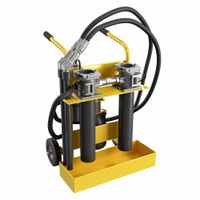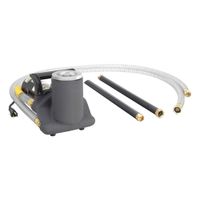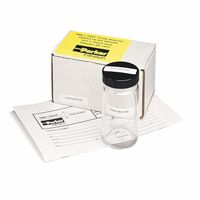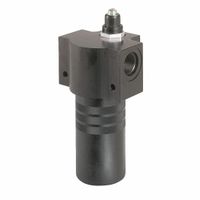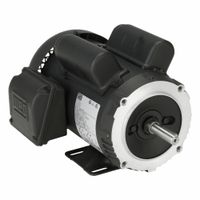Call +(254) 703 030 000 / 751 483 999 / 721 704 777
- Home
- Hydraulics
- Hydraulic Filtration
.....Read More
Frequently Asked Questions
What are hydraulic filtration products?
Hydraulic filtration products are essential components in hydraulic systems, designed to remove contaminants from hydraulic fluid. These contaminants, which can include dirt, metallic particles, water, and air, can lead to system malfunction, wear, and reduced efficiency if not properly controlled.
The primary function of hydraulic filtration is to maintain the cleanliness of the hydraulic fluid, thereby extending the lifespan of hydraulic components like pumps, valves, and actuators. Filters work by trapping particulate matter as the fluid passes through a filter media, which can vary in material and pore size depending on the specific application and required filtration level.
There are various types of hydraulic filtration products, each serving a distinct purpose: * **Suction filters** are placed before the pump to protect it from large particles.
* **Pressure filters** are located downstream of the pump, protecting sensitive components from contaminants generated by the pump or introduced into the system.
* **Return line filters** are positioned in the return line to the reservoir, cleaning the fluid before it re-enters the tank.
* **Off-line filters** (or kidney loop filters) are independent systems that continuously filter the fluid, often to achieve a higher level of cleanliness than can be maintained by in-line filters alone.
* **Breather filters** are installed on the hydraulic reservoir to prevent airborne contaminants from entering the system as the fluid level changes.Proper selection and maintenance of hydraulic filtration products are crucial for optimal hydraulic system performance, reliability, and longevity.
How do hydraulic filtration products work?
Hydraulic filtration products work by removing contaminants from hydraulic fluid, which is crucial for maintaining the efficiency and longevity of hydraulic systems. These systems rely on clean fluid to transmit power smoothly and prevent wear on components.
At their core, hydraulic filters consist of a filter medium (often made of cellulose, synthetic fibers, or wire mesh) housed within a casing. The hydraulic fluid passes through this medium, which is designed with specific pore sizes to trap solid particles, such as dirt, rust, and metal shavings. These particles can cause abrasion, block small orifices, and accelerate component degradation.
Different types of filters are used at various points in a hydraulic system. Suction filters protect the pump from large contaminants, return line filters clean the fluid returning to the reservoir, and pressure filters are placed downstream of the pump to protect sensitive components like valves and actuators. Some systems also employ off-line or kidney loop filtration for continuous cleaning.
As fluid flows through the filter, contaminants accumulate on the filter medium. This buildup eventually increases pressure drop across the filter, indicating that it is becoming clogged and needs to be replaced or cleaned. Regular maintenance and timely filter changes are essential to prevent system damage and ensure optimal performance. By effectively removing impurities, hydraulic filtration products help to minimize downtime, reduce repair costs, and extend the lifespan of hydraulic machinery.
Why is it important to keep hydraulic oil clean?
It is crucial to keep hydraulic oil clean because contaminants can significantly degrade the performance and lifespan of a hydraulic system. Even microscopic particles, such as dirt, dust, and water, can cause abrasive wear on precision components like pumps, valves, and cylinders, leading to premature failure. Water contamination, for example, can lead to rust and corrosion, and reduce the lubricating properties of the oil, forming acids and sludge. Air contamination, on the other hand, can cause cavitation, which damages pumps and other components.
Clean hydraulic oil ensures optimal lubrication, efficient power transmission, and reduced wear and tear on system components. This translates to fewer breakdowns, extended equipment life, and lower maintenance costs. Regular filtration and monitoring of oil cleanliness are essential practices to maintain system integrity and prevent costly repairs. Ultimately, a clean hydraulic system operates more reliably, efficiently, and safely.
What are the benefits of using hydraulic filtration carts?
Hydraulic filtration carts offer numerous benefits for maintaining hydraulic systems. Primarily, they extend the lifespan of hydraulic components by removing contaminants like dirt, water, and wear particles from the fluid. This reduction in contamination prevents abrasive wear, corrosion, and sludge formation, which are common causes of premature component failure.
By maintaining clean fluid, these carts also improve system efficiency and performance. Contaminated fluid can increase fluid viscosity, cause sticking valves, and lead to sluggish operation. Filtration carts ensure optimal fluid properties, leading to smoother operation, reduced energy consumption, and consistent power transmission.
Furthermore, using filtration carts can significantly reduce maintenance costs. Fewer component replacements mean less downtime for repairs and lower expenses for parts and labor. They also help in preventing costly system failures, which can halt production and lead to significant financial losses. Regular filtration also minimizes the need for complete fluid changes, saving on new fluid purchases and disposal costs.
In essence, hydraulic filtration carts are a proactive maintenance tool that enhances system reliability, optimizes performance, and provides substantial long-term cost savings by keeping hydraulic fluid clean and components protected.
How do handheld filtration units differ from other filtration systems?
Handheld filtration units are portable and designed for individual use, often in emergency or outdoor situations. They are typically compact, lightweight, and manually operated, relying on physical filtration methods like pumps or squeezable bags. Their primary advantage is immediate access to clean water in situations where traditional water sources are unavailable or contaminated.
In contrast, other filtration systems encompass a broad range of solutions, including household pitcher filters, faucet-mounted filters, under-sink systems, whole-house filtration, and industrial-scale treatment plants. These systems vary significantly in size, capacity, complexity, and filtration methods. Household systems often use activated carbon, ion exchange, or reverse osmosis, while larger systems may incorporate sedimentation, flocculation, and disinfection.
The key differences lie in scale, portability, and application. Handheld units prioritize portability and immediate, small-volume filtration for personal safety. Other systems prioritize convenience, higher flow rates, and more extensive treatment for sustained domestic or commercial use. While handheld units are crucial for survival and emergency preparedness, they are not designed for the continuous and high-volume water purification needs of homes or businesses.
What is the role of hydraulic tank filters?
Hydraulic tank filters are crucial components in hydraulic systems, primarily responsible for maintaining the cleanliness of the hydraulic fluid. Their main role is to remove contaminants such as dirt, dust, metal particles, and other debris that can enter the system during operation or maintenance. These contaminants, if left unchecked, can cause significant wear and tear on hydraulic components like pumps, valves, and cylinders, leading to reduced efficiency, increased downtime, and premature failure of the system.
By filtering the fluid, hydraulic tank filters help to prevent abrasive damage, maintain optimal system performance, and extend the lifespan of hydraulic components. They are typically located within or on top of the hydraulic reservoir, where they filter the fluid before it re-enters the system's circulation. Different types of tank filters exist, including suction filters, return line filters, and air breathers, each serving a specific purpose in ensuring the overall cleanliness and health of the hydraulic fluid. Regular maintenance and replacement of these filters are essential for the continuous and reliable operation of any hydraulic system.
How do in-line hydraulic filters function in a system?
In-line hydraulic filters are crucial components in hydraulic systems, designed to remove contaminants from the hydraulic fluid as it circulates. Their primary function is to protect sensitive components like pumps, valves, and actuators from wear, damage, and premature failure caused by particles such as dirt, metal shavings, and debris.
These filters are installed directly within the fluid flow path, either in the pressure line, return line, or suction line, depending on the system's design and filtration requirements. As the hydraulic fluid passes through the filter housing, it encounters a filter element, which is typically made of porous material like paper, synthetic fibers, or wire mesh. The element's pore size determines the smallest particles it can capture, with finer filtration ratings providing higher levels of cleanliness.
Contaminants larger than the filter's pore size are trapped on the surface or within the depth of the filter media, while the clean fluid continues its journey through the system. Over time, as more contaminants accumulate, the filter element can become clogged, leading to increased pressure drop across the filter and reduced fluid flow. This can negatively impact system performance and efficiency.
To address this, many in-line filters are equipped with a bypass valve. If the pressure differential across the filter becomes too high (indicating a clogged element), the bypass valve opens, allowing unfiltered fluid to bypass the element. While this prevents system starvation and maintains flow, it also means that contaminants are no longer being removed, highlighting the importance of regular filter maintenance and replacement. Pressure gauges or indicators are often used to monitor the filter's condition and signal when a replacement is needed, ensuring the continuous protection of the hydraulic system.
When should hydraulic interchangeable filter elements be replaced?
Hydraulic interchangeable filter elements should be replaced based on several factors, including pressure differential, operating hours, fluid analysis, and manufacturer recommendations. A common indicator is a rising pressure differential across the filter, often monitored by a clogging indicator or gauge. When this differential reaches a specified limit, it signifies the filter is accumulating contaminants and needs replacement. Regular fluid analysis can also reveal increasing particle counts, indicating filter inefficiency. Adhering to the equipment manufacturer's recommended service intervals, typically based on operating hours, is crucial for proactive maintenance. Additionally, if the hydraulic system exhibits signs of contamination, such as increased noise, sluggish operation, or premature component wear, the filter elements should be inspected and replaced as needed. Ignoring these indicators can lead to reduced system efficiency, component damage, and costly downtime.
How can hydraulic oil test kits help maintain system health?
Hydraulic oil test kits are invaluable tools for maintaining the health and longevity of hydraulic systems. These kits allow for on-site analysis of various properties of the hydraulic fluid, providing crucial insights into the system's operational condition. By regularly testing the oil, potential issues can be identified and addressed before they escalate into costly failures.
One of the primary benefits of these kits is their ability to detect contamination. Contaminants such as water, particulate matter, and air can significantly degrade oil quality, leading to increased wear on components and reduced system efficiency. Test kits can accurately measure the levels of these contaminants, enabling technicians to take corrective actions like filtration or oil replacement.
Furthermore, hydraulic oil test kits can assess the oil's chemical properties, such as viscosity, acidity, and additive depletion. Changes in viscosity can indicate overheating or degradation, while increased acidity can suggest oxidation and the formation of corrosive byproducts. Monitoring additive levels helps ensure the oil's protective properties are intact.
By providing early warning signs of problems, hydraulic oil test kits facilitate proactive maintenance. This approach minimizes downtime, extends the lifespan of hydraulic components, and optimizes overall system performance, ultimately leading to significant cost savings and improved operational reliability.
What are the common signs of contamination in hydraulic systems?
Contamination in hydraulic systems can manifest in several ways, impacting efficiency and longevity. Common signs include: * Slow or erratic operation: Contaminants can impede fluid flow and interfere with component movement, leading to sluggish or inconsistent performance.
* Increased noise levels: Cavitation, caused by air or moisture contamination, can produce unusual noises such as whining, rattling, or banging.
* Elevated operating temperatures: Friction from solid particles or degraded fluid due to contamination can generate excessive heat, potentially damaging seals and hoses.
* Frequent component failures: Contaminants act as abrasives, accelerating wear on pumps, valves, and cylinders, leading to premature failure.
* Changes in fluid appearance: The hydraulic fluid may appear cloudy, dark, or contain visible particles, indicating the presence of water, air, or solid contaminants.
* Unusual odors: A burnt or sour smell can indicate fluid degradation or overheating due to contamination.
* Leaking seals: Contaminants can damage seal surfaces, leading to external or internal leaks within the system.
* Increased power consumption: The system may require more power to perform tasks due to increased friction and resistance caused by contamination.Regular fluid analysis and preventive maintenance are crucial for detecting and mitigating contamination before it causes significant damage.
